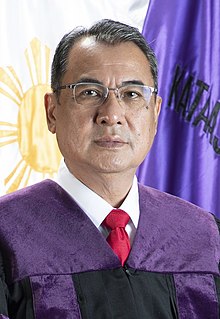| No.
|
Image
|
Chief justice
|
Tenure
|
Appointed by
|
Law school
|
Prior office
|
| 1
|

|
Cayetano Arellano
(1847–1920)
|
June 15, 1901
–
April 12, 1920
(18 years, 302 days)
(Resigned)
|
William McKinley
|
UST
|
President of the
Supreme Court
(1899–1901)
|
| 2
|

|
Victorino Mapa
(1855–1927)
|
July 1, 1920
–
October 31, 1921
(1 year, 122 days)
(Resigned)
|
Woodrow Wilson
|
Secretary of Justice
(1913–1920)
Associate Justice
of the Supreme Court
(1901–1913)
|
| 3
|

|
Manuel Araullo
(1853–1924)
|
November 1, 1921
–
July 26, 1924
(2 years, 268 days)
(Died)
|
Warren G. Harding
|
Associate Justice
of the Supreme Court
(1913–1921)
|
| 4
|

|
Ramon Avanceña
(1872–1957)
|
April 1, 1925
–
December 5, 1941
(16 years, 267 days)
(Resigned)
|
Calvin Coolidge
|
Associate Justice
of the Supreme Court
(1917–1925)
|
| 5
|

|
Jose Abad Santos
(1886–1942)
|
December 24, 1941
–
May 1, 19421
(128 days)
(Died)
|
Manuel L. Quezon
|
Northwestern
|
Associate Justice
of the Supreme Court
(1932–1941)
|
| 6
|

|
Jose Yulo
(1894–1976)
|
January 26, 1942
–
July 9, 1945
(3 years, 63 days)
(Resigned)
|
Masaharu Homma
|
UP
|
Speaker of the
National Assembly
(1939–1941)
|
| 7
|

|
Manuel Moran
(1893–1961)
|
July 9, 1945
–
March 20, 1951
(5 years, 254 days)
(Resigned)
|
Sergio Osmeña
|
Escuela de Derecho
|
Associate Justice
of the Supreme Court
(1938–1945)
|
| 8
|
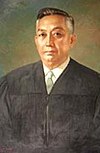
|
Ricardo Paras
(1891–1984)
|
April 2, 1951
–
February 17, 1961
(9 years, 321 days)
(Retired)
|
Elpidio Quirino
|
UP
|
Associate Justice
of the Supreme Court
(1941–1951)
|
| 9
|
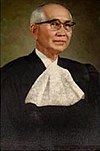
|
Cesar Bengzon
(1896–1992)
|
April 28, 1961
–
May 29, 1966
(5 years, 31 days)
(Retired)
|
Carlos P. Garcia
|
Associate Justice
of the Supreme Court
(1945–1961)
|
| 10
|

|
Roberto Concepcion
(1903–1987)
|
June 17, 1966
–
April 18, 1973
(6 years, 305 days)
(Retired)
|
Ferdinand Marcos
|
UST
|
Associate Justice
of the Supreme Court
(1954–1966)
|
| 11
|

|
Querube Makalintal
(1910–2002)
|
October 21, 1973
–
December 22, 1975
(2 years, 62 days)
(Retired)
|
UP
|
Associate Justice
of the Supreme Court
(1962–1973)
|
| 12
|
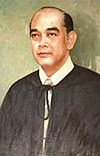
|
Fred Ruiz Castro
(1914–1979)
|
January 5, 1976
–
April 19, 1979
(3 years, 104 days)
(Died)
|
Associate Justice
of the Supreme Court
(1966–1976)
|
| 13
|
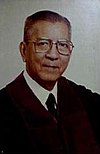
|
Enrique Fernando
(1915–2004)
|
July 2, 1979
–
July 24, 1985
(6 years, 22 days)
(Retired)
|
Associate Justice
of the Supreme Court
(1967–1979)
|
| 14
|

|
Felix Makasiar
(1915–1992)
|
July 25, 1985
–
November 19, 1985
(117 days)
(Retired)
|
Associate Justice
of the Supreme Court
(1970–1985)
|
| 15
|

|
Ramon Aquino
(1917–1993)
|
November 20, 1985
–
March 6, 1987
(1 year, 106 days)
(Resigned)
|
Associate Justice
of the Supreme Court
(1973–1985)
|
| 16
|
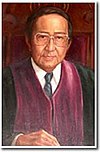
|
Claudio Teehankee
(1918–1989)
|
April 2, 1987
–
April 18, 1988
(1 year, 16 days)
(Retired)
|
Corazon Aquino
|
Ateneo
|
Associate Justice
of the Supreme Court
(1969–1987)
|
| 17
|

|
Pedro Yap
(1918–2003)
|
April 19, 1988
–
June 30, 1988
(72 days)
(Retired)
|
UP
|
Associate Justice
of the Supreme Court
(1986–1988)
|
| 18
|

|
Marcelo Fernan
(1927–1999)
|
July 1, 1988
–
December 6, 1991
(3 years, 158 days)
(Resigned)
|
Associate Justice
of the Supreme Court
(1986–1988)
|
| 19
|

|
Andres Narvasa
(1928–2013)
|
December 8, 1991
–
November 30, 1998
(6 years, 357 days)
(Retired)
|
UST
|
Associate Justice
of the Supreme Court
(1986–1991)
|
| 20
|

|
Hilario Davide Jr.
(born 1935)
|
November 30, 1998
–
December 20, 2005
(7 years, 20 days)
(Retired)
|
Joseph Estrada
|
UP
|
Associate Justice
of the Supreme Court
(1991–1998)
|
| 21
|
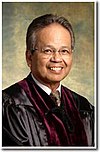
|
Artemio Panganiban
(born 1937)
|
December 20, 2005
–
December 7, 2007
(1 year, 352 days)
(Retired)
|
Gloria Macapagal Arroyo
|
FEU
|
Associate Justice
of the Supreme Court
(1995–2005)
|
| 22
|
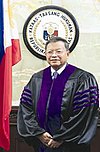
|
Reynato Puno
(born 1940)
|
December 7, 2007
–
May 17, 2010
(2 years, 161 days)
(Retired)
|
UP
|
Associate Justice
of the Supreme Court
(1993–2007)
|
| 23
|

|
Renato Corona
(1948–2016)
|
May 17, 2010
–
May 29, 20122 3
(2 years, 12 days)
(Impeached)
|
Ateneo
|
Associate Justice
of the Supreme Court
(2002–2010)
|
| –
|

|
Maria Lourdes Sereno
(born 1960)
|
August 25, 2012
–
May 11, 20183 4
(5 years, 259 days)
(De facto Chief Justice,
appointment null and void ab initio)
|
Benigno Aquino III
|
UP
|
Associate Justice
of the Supreme Court
(2010–2012)
|
| 24
|
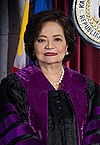
|
Teresita de Castro
(born 1948)
|
August 28, 2018
–
October 10, 20183 5
(43 days)
(Retired)
|
Rodrigo Duterte
|
Associate Justice
of the Supreme Court
(2007–2018)
|
| 25
|
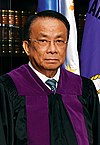
|
Lucas Bersamin
(born 1949)
|
November 26, 2018
–
October 18, 2019
(326 days)
(Retired)
|
UE
|
Associate Justice
of the Supreme Court
(2009–2018)
|
| 26
|
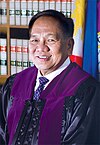
|
Diosdado Peralta
(born 1952)
|
October 23, 2019
–
March 27, 2021
(1 year, 155 days)
(Resigned)
|
UST
|
Associate Justice
of the Supreme Court
(2009–2019)
|
| 27
|

|
Alexander Gesmundo
(born 1956)
|
April 5, 2021
–
present
(3 years, 76 days)
|
Ateneo
|
Associate Justice
of the Supreme Court
(2017–2021)
|


